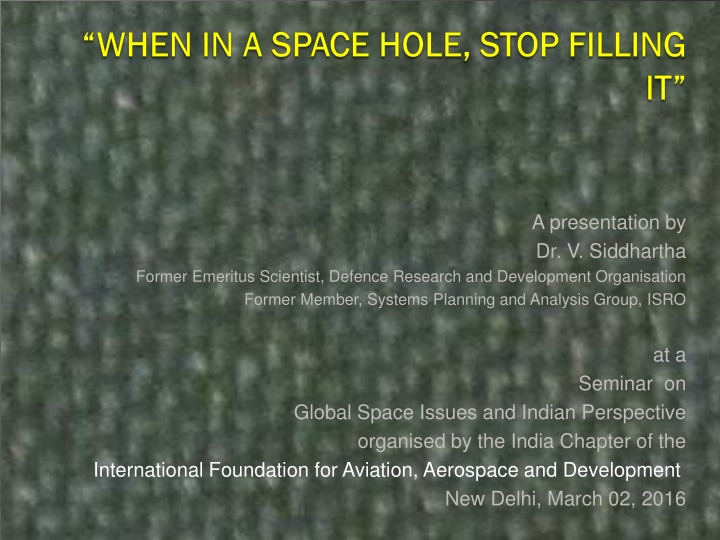
Global Space Issues: Challenges and Solutions
Explore the challenges of space debris and potential solutions discussed by Dr. V. Siddhartha at the Seminar on Global Space Issues and Indian Perspective. Issues include congestion, competition, and the need for an ASAT ban treaty to mitigate risks. Learn about past precedents in nuclear testing bans and the importance of international collaboration in space debris control. Dive into the intricacies of space governance and the evolving landscape of space policy.
Download Presentation

Please find below an Image/Link to download the presentation.
The content on the website is provided AS IS for your information and personal use only. It may not be sold, licensed, or shared on other websites without obtaining consent from the author. If you encounter any issues during the download, it is possible that the publisher has removed the file from their server.
You are allowed to download the files provided on this website for personal or commercial use, subject to the condition that they are used lawfully. All files are the property of their respective owners.
The content on the website is provided AS IS for your information and personal use only. It may not be sold, licensed, or shared on other websites without obtaining consent from the author.
E N D
Presentation Transcript
WHEN IN A SPACE HOLE, STOP FILLING WHEN IN A SPACE HOLE, STOP FILLING IT IT A presentation by Dr. V. Siddhartha Former Emeritus Scientist, Defence Research and Development Organisation Former Member, Systems Planning and Analysis Group, ISRO at a Seminar on Global Space Issues and Indian Perspective organised by the India Chapter of the International Foundation for Aviation, Aerospace and Development New Delhi, March 02, 2016
Congested, Competitive, Contested Not to say Clich d, as in: The Space sanitation issue is at the tipping point . Except that at the tipping point is true, not so much for the three title characteristics, but because near- Space is now vulnerable to cascade debrification that is, collisions between extant debris and active satellites -- or other debris -- causes more debris, which causes [V. Adushkin et. al. Orbital missions safety A survey of kinetic hazards, Acta Astronautica, (2016)]
Space Arms, or Debris Control? > The EU code proposal is a Trojan horse; a Space ASAT-NPT in the offing. Former Scientific Adviser to the Defence Minister, and current member Niti Ayog, warned as much at the 1916 Kalpana Chawla Annual Space Policy Dialogue last week in New Delhi. > If the ASAT-capable powers do not prioritise the debris-limitation essential, over the Space arms control desirable, they will - a la Buridan s ass - achieve neither objective, to the detriment of themselves and all Space users alike.
N-Test ban precedents > When nuclear weapons testing in the commons of Space, the oceans and the atmosphere began to irreversibly threaten the use of these commons, verifiable treaties were negotiated between the N-powers to ban N- testing in those commons (LTBT, 1963) > When underground N-testing above a threshold yield (150kT) was considered not a strategic necessity, a verifiable Threshold Test Ban Treaty was agreed (TTBT, 1974)
A Threshold ASAT-ban treaty is do- able > Debris which descend to, or are created at, heights of below 90-100 kM burn-up in days or weeks. > That height was established by the Japanese Hiten spacecraft aerobrake experiment (1991). > That threshold band may be readily re- established by an internationally collaborated Space experiment, following which, a Threshold ASAT-ban Treaty is entirely do- able. [Kaul and Siddhartha, 2012]
.. Thank you
